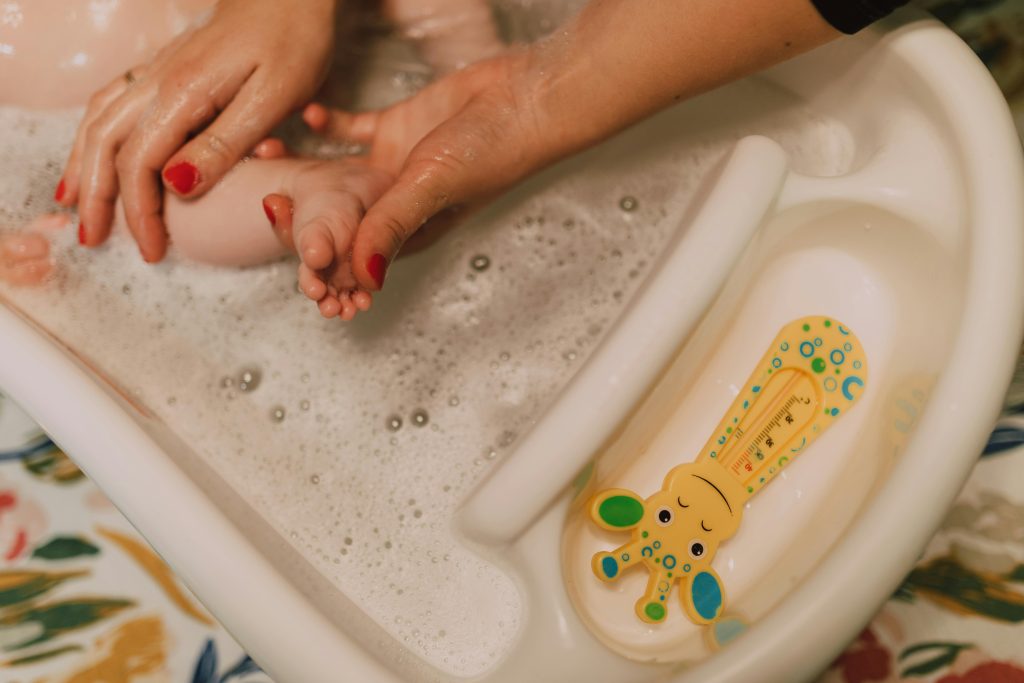
🛁 Splash, giggle, and squeak! Bath time can be a delightful adventure for both baby and parent. But for many new parents, it can also be a source of anxiety. How do you keep your little one safe while ensuring they have a blast? If you’ve ever found yourself fretting over bath time, you’re not alone.
Imagine transforming bath time from a potentially stressful experience into a joyful bonding ritual with your baby. Picture the smiles, the laughter, and the precious memories you’ll create. In this comprehensive guide, we’ll walk you through everything you need to know about making bath time both fun and safe for your little one. From setting up the perfect bathing environment to tackling common challenges, we’ve got you covered. Get ready to dive into a world of bubbles, toys, and giggles as we explore the six essential aspects of a successful bath time routine!
Setting the Stage for a Safe Bath
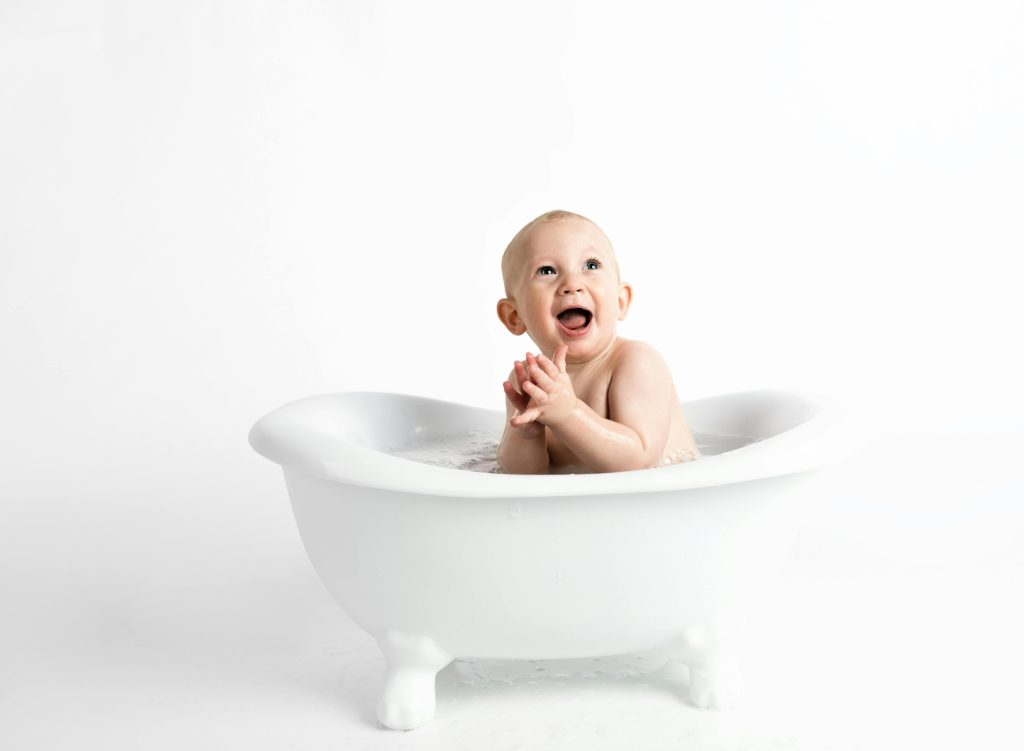
A. Choosing the right bathtub
When it comes to selecting a bathtub for your baby, safety and comfort are paramount. Consider these options:
- Infant tub: Ideal for newborns and young infants
- Convertible tub: Grows with your baby
- Sink insert: Perfect for small spaces
- Inflatable tub: Great for travel
| Tub Type | Age Range | Pros | Cons |
|---|---|---|---|
| Infant tub | 0-6 months | Contoured, secure | Outgrown quickly |
| Convertible | 0-24 months | Long-lasting | Bulky to store |
| Sink insert | 0-6 months | Space-saving | Limited use |
| Inflatable | 6-24 months | Portable | Requires inflation |
B. Gathering essential bath supplies
Before bathing your baby, ensure you have all necessary items within arm’s reach:
- Gentle baby soap and shampoo
- Soft washcloth
- Hooded towel
- Clean diaper and clothes
- Lotion or oil for after-bath moisturizing
C. Preparing the bathroom environment
Create a safe and comfortable bathing space by:
- Setting room temperature to 75-80°F (24-27°C)
- Removing tripping hazards
- Placing a non-slip mat near the tub
- Ensuring proper lighting
D. Testing water temperature
Always check the water temperature before placing your baby in the tub:
- Aim for 100°F (38°C)
- Use a bath thermometer for accuracy
- Test with your elbow or wrist if a thermometer is unavailable
Remember, never leave your baby unattended during bath time. With these preparations in place, you’re ready to make bath time both safe and enjoyable for your little one.
Making Bath Time Enjoyable
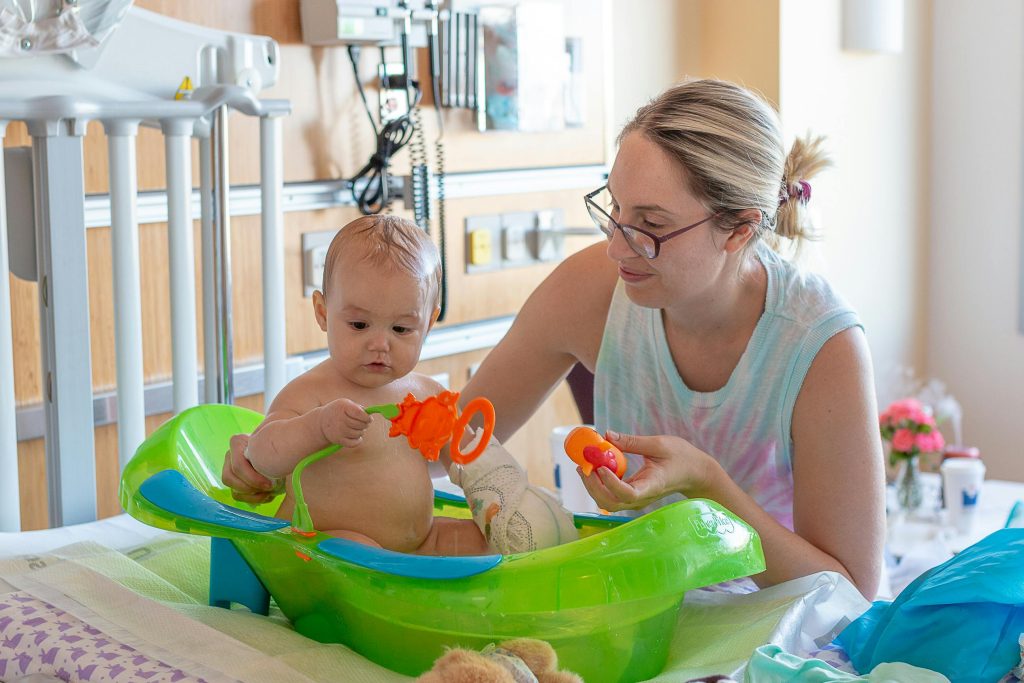
Introducing fun bath toys
Bath toys are essential for making bath time enjoyable for your little one. Here’s a list of popular bath toys that can keep your baby entertained:
- Rubber ducks
- Floating boats
- Waterproof books
- Stacking cups
- Squirt toys
Choose toys that are age-appropriate and free from small parts that could pose a choking hazard.
Singing songs and playing games
Engage your baby with simple songs and games during bath time. This not only makes the experience more enjoyable but also aids in their development. Try these ideas:
- Sing nursery rhymes like “Rubber Duckie” or “Splish Splash”
- Play peek-a-boo with a washcloth
- Count body parts as you wash them
- Create funny hairstyles with shampoo
Using colorful and scented bath products
Stimulate your baby’s senses with colorful and mildly scented bath products. Here’s a comparison of some baby-friendly options:
| Product Type | Benefits | Considerations |
|---|---|---|
| Colored bath tablets | Visual stimulation | Avoid strong dyes |
| Bubble bath | Fun texture | Use sparingly to prevent skin dryness |
| Scented soap | Aromatherapy | Choose mild, natural scents |
| Bath crayons | Encourage creativity | Ensure easy cleanup |
Creating a relaxing atmosphere
Set the mood for a calming bath experience. Dim the lights slightly and play soft background music. Consider using a gentle nightlight or projector to create a soothing ambiance. This can help your baby associate bath time with relaxation, making it easier to incorporate into a bedtime routine.
Essential Safety Measures

Never leaving baby unattended
When it comes to bath time safety, the most crucial rule is to never leave your baby unattended, even for a moment. Babies can quickly slip underwater or turn over, leading to potential drowning hazards. Always keep one hand on your baby and maintain constant visual contact.
Preventing slips and falls
To ensure a safe bathing experience, take measures to prevent slips and falls:
- Use a non-slip bath mat inside the tub
- Keep bath toys organized and out of the way
- Ensure the bathroom floor is dry and clutter-free
Proper handling techniques
Proper handling of your baby during bath time is essential for safety:
- Support your baby’s head and neck at all times
- Use a gentle, firm grip when washing and rinsing
- Avoid sudden movements that could startle your baby
Monitoring water levels
Maintaining appropriate water levels is crucial for your baby’s safety:
| Age Group | Recommended Water Depth |
|---|---|
| Newborns | 2-3 inches (5-7.5 cm) |
| 6+ months | 4-6 inches (10-15 cm) |
Always check the water temperature before placing your baby in the tub. Use a bath thermometer to ensure the water is between 90-100°F (32-38°C). Remember, a baby’s skin is more sensitive than an adult’s, so what feels lukewarm to you might be too hot for your little one.
With these essential safety measures in place, you can focus on making bath time an enjoyable and bonding experience for both you and your baby. Next, we’ll explore how to establish a consistent bath time routine that works for your family.
Establishing a Bath Time Routine
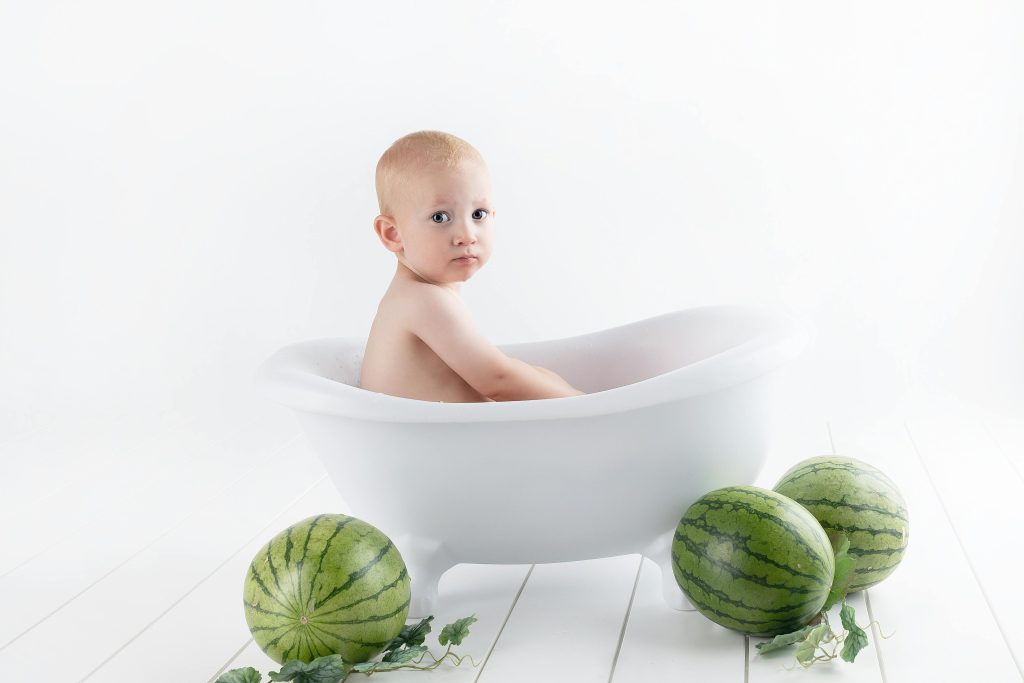
Choosing the best time of day
When establishing a bath time routine for your baby, selecting the right time of day is crucial. Consider your baby’s natural rhythm and daily schedule. Many parents find that evening baths help calm their babies before bedtime, while others prefer morning baths to energize their little ones for the day ahead.
| Time of Day | Pros | Cons |
|---|---|---|
| Morning | Energizing start to the day | May interfere with nap time |
| Afternoon | Flexible timing | Can disrupt daily activities |
| Evening | Relaxing before bedtime | May be challenging if baby is tired |
Creating a consistent sequence of steps
Consistency is key when establishing a bath time routine. Follow these steps to create a smooth and predictable experience:
- Gather all necessary supplies before starting
- Undress baby and check the water temperature
- Gently lower baby into the tub
- Wash from top to bottom, saving diaper area for last
- Rinse thoroughly with clean water
- Lift baby out and wrap in a warm towel
Gradually increasing bath duration
As your baby grows and becomes more comfortable with bath time, you can slowly extend the duration of each bath. Start with short, 3-5 minute sessions for newborns, and gradually increase to 10-15 minutes for older babies. This progression allows your baby to build positive associations with bath time while also providing ample opportunity for play and bonding. Remember to always prioritize safety and comfort, adjusting the duration based on your baby’s cues and preferences.
Addressing Common Bath Time Challenges
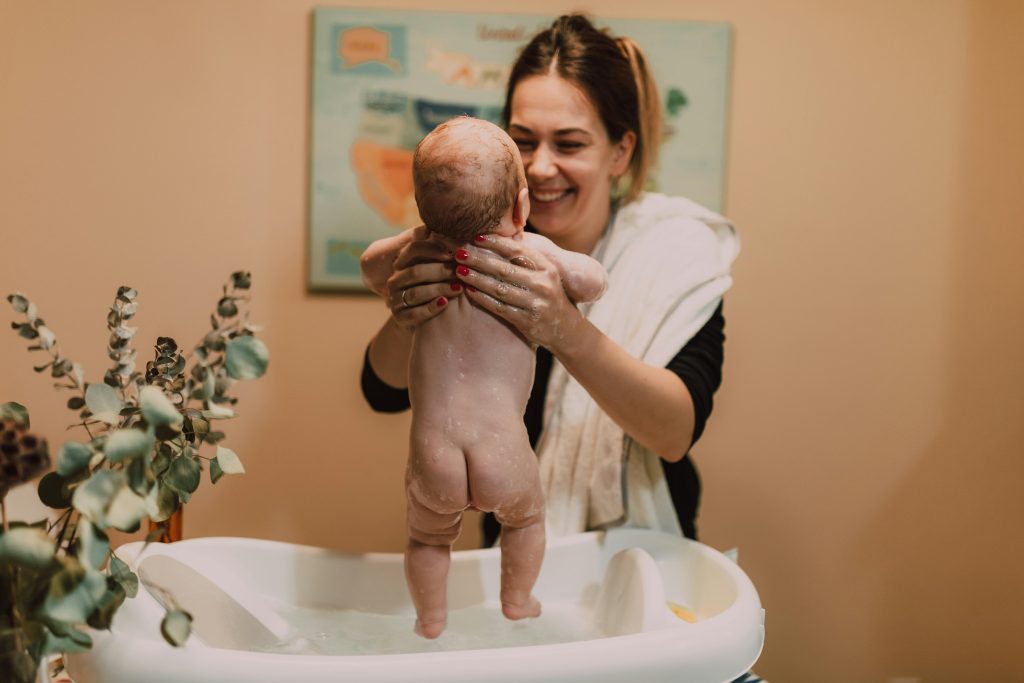
Dealing with fear of water
Some babies may develop a fear of water, making bath time stressful. To help ease this anxiety:
- Start with shallow water and gradually increase depth
- Use fun toys to distract and create positive associations
- Sing songs or play games during bath time
- Consider a bath seat for added security
Managing squirmy or fussy babies
Keeping active babies safe and engaged during bath time can be challenging. Try these strategies:
- Use colorful, floating toys to capture their attention
- Play simple games like “find the rubber duck”
- Keep bath time short and efficient
- Consider bathing with your baby for added security
Handling sensitive skin issues
For babies with sensitive skin, bath time requires extra care:
| Tip | Explanation |
|---|---|
| Use lukewarm water | Hot water can dry out and irritate skin |
| Choose gentle, fragrance-free products | Harsh chemicals can cause irritation |
| Limit bath time | Prolonged exposure to water can dry skin |
| Pat dry gently | Avoid rubbing, which can irritate sensitive skin |
Tackling post-bath struggles
After-bath routines can be just as challenging. Here’s how to make the transition smoother:
- Have a warm towel ready to wrap baby immediately
- Use this time for gentle massage with baby-safe lotion
- Keep the room warm to prevent chills
- Make dressing fun with silly games or songs
Remember, consistency and patience are key in overcoming these common bath time challenges. With time and practice, both you and your baby will find a routine that works best.
After-Bath Care

Gentle drying techniques
After a soothing bath, it’s crucial to dry your baby gently and thoroughly. Use a soft, hooded towel to wrap your little one immediately after lifting them from the tub. Pat their skin dry, paying special attention to skin folds and creases where moisture can linger. Avoid rubbing, as this can irritate sensitive baby skin.
| Drying Technique | Benefit |
|---|---|
| Pat drying | Gentle on skin, prevents irritation |
| Hooded towel | Keeps baby warm, dries hair easily |
| Focus on folds | Prevents moisture-related skin issues |
Moisturizing baby’s skin
After drying, apply a gentle, hypoallergenic moisturizer to keep your baby’s skin soft and hydrated. This is especially important if your little one has dry or sensitive skin.
- Choose fragrance-free, pediatrician-approved lotions
- Apply moisturizer while skin is still slightly damp
- Gently massage the lotion into the skin, promoting bonding
Dressing for comfort
Select soft, breathable clothing for your baby post-bath. Opt for natural fibers like cotton, which are gentle on the skin and help regulate body temperature.
Transitioning to bedtime
A bath can be an excellent part of a bedtime routine, helping to signal that it’s time to wind down. After dressing your baby, consider some quiet activities like reading a story or singing a lullaby to further promote relaxation. This smooth transition from bath time to bedtime can help establish healthy sleep habits for your little one.
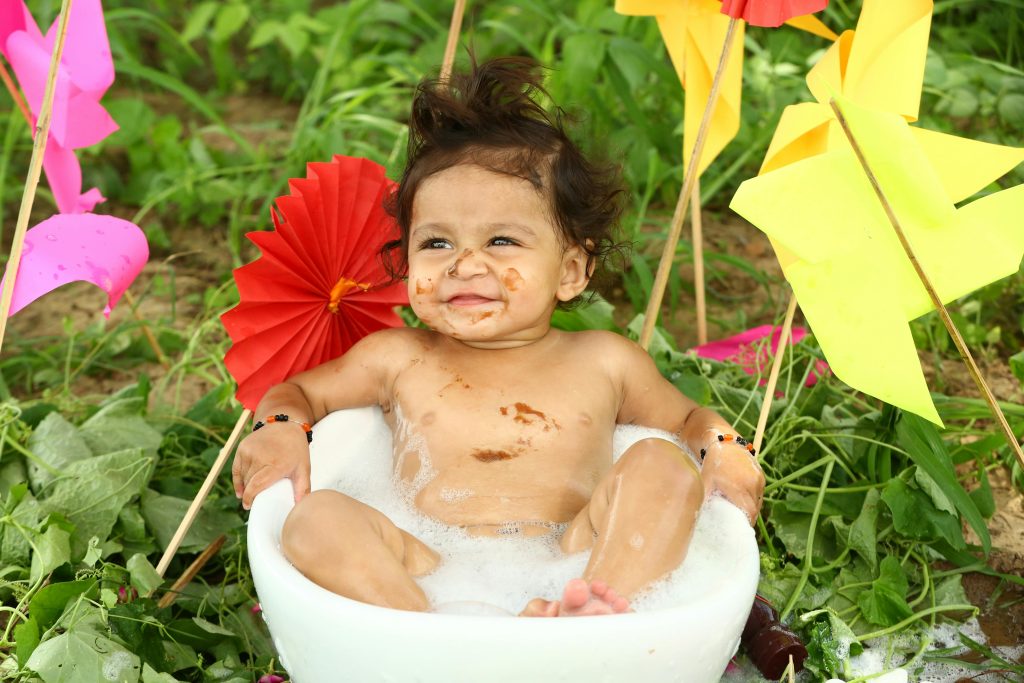
Bath time can be a wonderful opportunity for bonding with your baby while ensuring their cleanliness and safety. By creating a comfortable environment, using engaging toys, and implementing essential safety measures, you can transform this daily routine into a fun and secure experience for both you and your little one.
Remember to establish a consistent bath time routine and address any challenges that may arise with patience and creativity. After the bath, continue the care with gentle drying and moisturizing to keep your baby’s skin healthy. With these tips in mind, you’ll be well-equipped to make bath time a delightful and safe part of your baby’s day.





